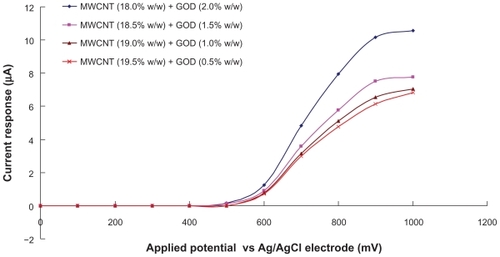Abstract
This study aims to develop an amperometric glucose biosensor, based on carbon nanotubes material for reverse iontophoresis, fabricated by immobilizing a mixture of glucose oxidase (GOD) and multiwalled carbon nanotubes (MWCNT) epoxy-composite, on a planar screen-printed carbon electrode. MWCNT was employed to ensure proper incorporation into the epoxy mixture and faster electron transfer between the GOD and the transducer. Results showed this biosensor possesses a low detection potential (+500 mV), good sensitivity (4 μA/mM) and an excellent linear response range (r2 = 0.999; 0–4 mM) of glucose detection at +500 mV (versus Ag/AgCl). The response time of the biosensor was about 25 s. In addition, the biosensor could be used in conjunction with reverse iontophoresis technique. In an actual evaluation model, an excellent linear relationship (r2 = 0.986) was found between the glucose concentration of the actual model and the biosensor’s current response. Thus, a glucose biosensor based on carbon nanotube composites and incorporated with reverse iontophoresis function was developed.
Introduction
The discovery of carbon nanotube (CNT) in 1991, led to many new technical developments and applications because of the characteristics of large surface area, unique electronic properties, and relatively high mechanical strength associated with it.Citation1 Recent studies demonstrated high electrocatalytic effect and fast electron-transfer rate in CNT materialCitation2–Citation6 and thereby provide a new material for fabricating biosensors.Citation7,Citation8 Moreover, CNT can reduce the surface fouling on electrochemical devices without a mediator. The ability of CNT in facilitating electron transfer of hydrogen peroxide (H2O2) shows great promise as oxidase-based amperometric biosensors.Citation6,Citation9 To the best of our knowledge there is no report on the use of CNT composites in glucose biosensor, incorporated with reverse iontophoresis function, for noninvasive glucose monitoring.
Reverse iontophoresis is a technique using a small electric charge to extract both charged and neutral molecules through the skin, recently used for patient monitoring.Citation10–Citation15 The authors only found reports of a glucose sensor integrated with reverse iontophoresis function.Citation11,Citation14–Citation30 This glucose biosensor, approved by the US Food and Drug Administration, is GlucoWatch® biographer, which passes a small current between two skin-surface hydrogel electrodes to extract glucose-containing interstitial fluid into hydrogel pads, incorporating a glucose oxidase (GOD) biosensor.Citation14,Citation17,Citation31 Unfortunately, GlucoWatch causes several problems, such as skin irritation or rash under the device in a number of patients. This problem may be due to the immobilization of GOD inside the hydrogel pads releasing peroxide. Even worse, GlucoWatch is unreliable in detecting hypoglycemia and hyperglycemia.Citation16
The aim of this study is thus to find out the optimum combination of multiwalled carbon nanotubes and GOD for a glucose biosensor, in order to develop a new glucose biosensor incorporated with reverse iontophoresis function for noninvasive glucose monitoring. The glucose biosensor for reverse iontophoresis was eventually evaluated in this study.
Materials and methods
Reagents and solutions
All reagents used in this study, were commercially available and used without further purification: GOD (type VII), β–D(+) glucose, phosphate buffered saline, multiwalled carbon nanotubes (MWCNT, 0.5–50 μm, >95% purity) powders were purchased from Sigma Chemical Co. (St. Louis, MO, USA); Methylcellulose (MC, Methocel A4M Prem) from Dow Chemical Co. (Midland, MI, USA). Deionized water purified by a Millipore System (Milli-Q UFplus; Bedford, MA, USA) was used to prepare all solutions. Graphite paste, silver paste, silver-silver chloride (Ag/AgCl) paste, and insulating paste were purchased from Advanced Conductive Materials (Atascadero, CA, USA). Epoxy (EPO-TEK® 509FM-1) was purchased from Epoxy Technology (Billerica, MA, USA). Polyethylene terephthalate (PETE) sheet was purchased from 3M.
Construction of the glucose biosensor
The construction steps of a planar three-electrode transducer were shown schematically in , according to the procedure described earlier.Citation32 The transducer was then used for glucose biosensor construction.
Figure 1 Construction steps for the planar configuration of the screen-printed transducer. a) (PETE) support material; b) conducting silver basal track; c) insulation layer; d) Ag/AgCl pads, the iontophoresis electrode (the central circular one) for reverse iontophoresis and the reference electrode; e) graphite pads, the working and counter electrodes.
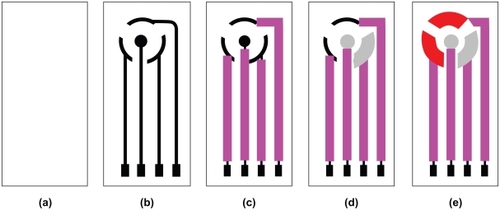
A biocomposite paste was prepared by mixing MWCNT (18.0%–19.5% w/w) with GOD (0.5%–2.0% w/w), followed by the incorporation of epoxy (80.0% w/w) and further 30 minutes mixing, in order to obtain a homogeneous biocomposite paste. This paste (10 μL) was then coated onto the surface of a graphite pad (working electrode) of the transducer and dried for 3 days at 30°C. Unused glucose biosensors were kept in the dark at 4°C.
Hydrodynamic voltammetry measurements of the glucose biosensor
Using an electrochemical interface (electrochemical interface SI1286, Schlumberger Technologies, England), measurements were taken at 25°C with the biosensor in a solution of 4 mM glucose in 0.1 M phosphate buffer (pH 7.0) subjected to constant stirring. Incremental potentials (0–1000 mV, 100 mV increments) versus Ag/AgCl pad were applied to the working electrode of the biosensor and the current responses of the biosensor to glucose were measured.
Measurements of the biosensor current response to glucose
Measurements were carried out at 25°C at the electrochemical interface. The biosensor was placed in a cell containing 0.1 M phosphate buffer solution pH 7.0, subjected to constant stirring, employed as supporting electrolyte. An applied potential of +500 mV versus Ag/AgCl pad was applied to the working electrode of the biosensor. After the background current stabilized, different glucose solution was added to the constantly-stirred buffer solution and the current response of the biosensor to glucose was then measured.
Evaluation of the ferrocene-mediated glucose biosensor for reverse iontophoresis
A 90 μL of a 4% MC gel (prepared by mixing 4 g of MC with 100 mL of 0.1 M phosphate buffer pH 7.0) was laced onto two biosensors made up of optimum combination of MWCNT (18.0% w/w) and GOD (2.0% w/w). The two biosensors were then fixed onto the nanoporous membrane (Spectra/Por® CE, MWCO: 500, Spectrum Laboratories, Inc., Canada) of our custom-developed diffusion cell,Citation33 filled with different concentrations of glucose solutions, and the iontophoresis electrode center of the biosensors was 23 mm apart. Using our custom-developed reverse iontophoresis deviceCitation34 at room temperature (22–24°C), a bipolar current (0.3 mA/cm2, period = 30 minutes, ie, 555.6 μHz) was passed between the iontophoresis electrodes for 90 minutes. At the end of the experiment, biosensors were connected to the electrochemical interface for current response measurement and an applied potential of +500 mV versus Ag/AgCl pad was applied to the working electrode.
Results and discussion
The amperometric transducer
Good inert behavior of the counter electrode is very important and hence elements such as gold and platinum are commonly used.Citation35,Citation36 On the other hand, there is no report of any meaningful relationship between current density and the materials used and their geometries.Citation37 Therefore graphite, an inert material, was used as counter electrode material in this study based on their availability and affordability.
The ratio of counter electrode area to working electrode area (AC/AW), can exert influence on the supply of determined current to the working electrode without limiting its response.Citation38 The optimal AC/AW ratio was reported to be in the range of 1 and 12.Citation39–Citation43 Composite material used in this study allows fabrication of an inert graphite counter electrode with an AC/AW ratio of at least 0.125. Furthermore, there is no great difference between the current density of transducer constructed with AC/AW ratio 0.11 and 9.20.Citation37 Therefore the AC/AW ratio of 1 was employed on constructing the amperometric transducer in this study.
Hydrodynamic voltammogram of the glucose biosensor
Several reportsCitation7,Citation8 have suggested that carbon nanotube can significantly facilitates catalytic effect, both on the reduction and oxidation of hydrogen peroxide (H2O2), making it highly sensitive in detection of H2O2. illustrated the hydrodynamic voltammogram of the biosensors at a constantly-stirred solution of 4 mM glucose in 0.1 M phosphate buffer (pH 7.0). It was found that the oxidation currents generated by the biosensors begin at potential about +500 mV. Carbon nanotube therefore can significantly facilitate the electron transfer between H2O2 molecules.Citation7,Citation8 Moreover, carbon nanotube promotes the low oxidation potential amperometric determination of glucose. As shown in , biosensor with the combination of MWCNT (18.0% w/w) and GOD (2.0% w/w) is optimal for detecting and generating glucose signals, than mixture with other ratios.
Calibration of the biosensor to glucose
showed a current-time curve, where steps correspond to current response of the biosensor (MWCNT [18.0% w/w] and GOD [2.0% w/w] mixture) at the applied potential of +500 mV, for successive additions of 4 mM glucose in 0.1 M phosphate buffer solution (pH 7.0). Immediately after the addition of glucose solution, the reductive current increased and reached 95% of the steady state current at about 25 seconds. The response time of our biosensor is comparable to that reported by Antiochia and Gorton.Citation44
Figure 3 Current-time curve obtained by successive addition of 4 mM glucose solution to the biosensor. Data is obtained from biosensor with the combination of MWCNT (18.0% w/w) and GOD (2.0% w/w).
Abbreviations: GOD, glucose oxidase; MWCNT, multiwalled carbon nanotubes.
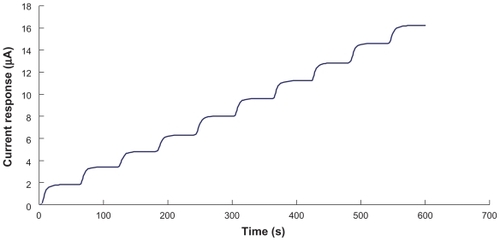
From the data of current-time curves, the magnitude of current response was plotted against the glucose concentration (see ) and the sensitivity of the biosensor was determined by the slope of linear regression of this current response versus glucose concentration. The current response is directly proportional to the glucose concentration over a wide range of concentration (0–4 mM), where correlation coefficient is greater than 0.997. Since the amount of transdermal glucose extraction by reverse iontophoresis is in the order of μM,Citation28 the range of measurement of glucose biosensor designed in this study can detect the normal concentrations of transdermally extracted glucose with good accuracy.
Figure 4 Calibration curves of the biosensors to glucose concentration. The lines are best fit found by linear regression. Sensitivity of the biosensor is indicated by the slope of the linear regression line.
Abbreviations: GOD, glucose oxidase; MWCNT, multiwalled carbon nanotubes.
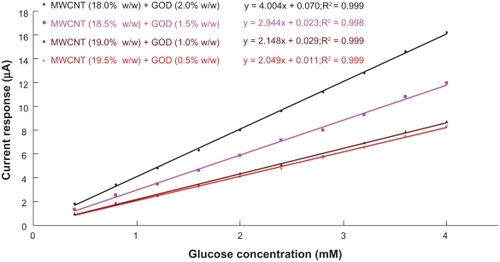
Biosensor constructed with MWCNT (18.0% w/w) and GOD (2.0% w/w), as shown in , has the greatest sensitivity of 4.0 μA/mM, more than 1.36 times the other biosensors. Therefore, the combination of 18.0% w/w of MWCNT and 2.0% w/w of GOD is considered as the optimum combination for constructing glucose biosensor in this study.
The reproducibility in the construction of the biosensor was evaluated from standard deviation of biosensor sensitivity. As shown in , the relative standard deviation of biosensor sensitivity indicated a batch reproducibility of biosensor construction of about 4% (n = 5).
Table 1 The sensitivity (n = 5) of the biosensor at different combinations of glucose oxidase (GOD) loading and multiwalled carbon nanotubes (MWCNT) loading
Although the glucose biosensor of the GlucoWatch has a linear (r2 ~ 0.98) glucose response range of 0–28 mM which is larger than the one in this study (r2 ~ 1.00, 0–4 mM), the amount of transdermal glucose extraction by reverse iontophoresis are several orders of magnitude lower than those present in the blood (~5 μM vs ~ 5 mM).Citation28 Therefore, our glucose biosensor can cover the concentrations of the transdermally extracted glucose and be useful in a clinical setting.
The use of the biosensor for noninvasive glucose measurement by reverse iontophoresis
The biosensor, with the optimum combination of MWCNT (18.0% w/w) and GOD (2.0% w/w), coupled to our custom-developed reverse iontophoresis deviceCitation34 has been tested in this study. Transmembrane (the membrane of the diffusion cell) glucose extraction, achieved by means of the reverse iontophoresis, was then quantified by the biosensor. The magnitude of the biosensor current response was plotted against the glucose concentration inside the diffusion cell (see ). In order to simulate hypoglycemia, normal and hyperglycemia situations, glucose concentrations of 3 mM, 5 mM and 15 mM was chosen respectively for testing inside the diffusion cell. An excellent linear relationship (r2 = 0.99) was found between the diffusion cell glucose concentration (3–15 mM) and biosensor current response. Based on the results, our glucose biosensor was accurate enough to be used to measure glucose levels in both condition of hypoglycemia and hyperglycemia, as opposed to GlucoWatch®’s unreliability in detecting hypoglycemia and hyperglycemia.Citation45
Figure 5 Evaluation of the biosensor for noninvasive glucose measurement by reverse iontophoresis. An excellent linear relationship (r2 = 0.986) between the biosensor current response and glucose concentration in diffusion cell was found. Data (n = 5) was obtained from biosensor with the optimum combination of MWCNT (18.0% w/w) and GOD (2.0% w/w). The diffusion cell was filled with an electrolyte solution comprising 0.1 M phosphate buffer (pH 7.0) and 3–15mM glucose.
Abbreviations: GOD, glucose oxidase; MWCNT, multiwalled carbon nanotubes.
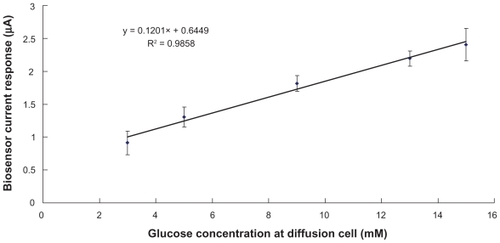
Conclusion
A simple, low-cost carbon nanotube composite-based glucose biosensor with low oxidation potential and high sensitivity was developed in this study. The use of the biosensor incorporated with reverse iontophoresis for noninvasive glucose determination at glucose range for hypoglycemia, normal and hyperglycemia situations were also demonstrated to be successful and potentially useful in clinical setting, better than the presently commercialized product.
Acknowledgments
This work was supported by grants (NSC 98-2221-E-260- 002- and NSC 98-2221-E-260-024-MY3) from National Science Council, Taiwan, Republic of China. Also, this work was partially supported by grant (98A032) from the National Chi Nan University and Puli Christian Hospital, Taichung, Taiwan, Republic of China.
Disclosure
The authors report no conflicts of interest in this work.
References
- MooreRRBanksCEComptonRGBasal plane pyrolytic graphite modified electrodes: comparison of carbon nanotubes and graphite powder as electrocatalystsAnal Chem2004762677268215144174
- GongKZhangMYanYSol-gel-derived ceramic-carbon nanotube nanocomposite electrodes: tunable electrode dimension and potential electrochemical applicationsAnal Chem2004766500650515516147
- LinYRaoAMSadanadanBFunctionalizing multi-walled carbon nanotubes with aminopolymersJ Phys Chem B200210612941298
- JiangKEitanASchadlerLSSelective attachment of gold nanoparticles to nitrogen-doped carbon nanotubesNano Lett20033275277
- EitanAJiangKYDukesDSurface modification of multiwalled carbon nanotubes: toward the tailoring of the interface in polymer compositesChem Mater20031531983201
- ZhangMGSmithAGorskiWCarbon nanotube-chitosan system for electrochemical sensing based on dehydrogenase enzymesAnal Chem2004765045505015373440
- ZhaoQGanZZhuangQElectrochemical sensors based on carbon nanotubesElectroanal20021416091613
- LiNWangJLiMElectrochemistry at carbon nanotube electrodesRev Anal Chem2003221934
- JiangLYWangRXLiXMElectrochemical oxidation behavior of nitrite on a chitosan-carboxylated multiwall carbon nanotube modified electrod electrochemElectrochem Commun2005597597601
- DegimITIlbasmisSDundarozROguzYReverse iontophoresis: a noninvasive technique for measuring blood urea levelPediatr Nephrol2003181032103712898373
- PitzerKRDesaiSDunnTDetection of hypoglycaemia with the GlucoWatch biographerDiabetes Care20012488188511347748
- PottsROTamadaJATierneyMJGlucose monitoring by reverse iontophoresisDiabetes Metab Res Rev200218S495311921430
- RaoGGuyRHGlikfeldPReverse iontophoresis: noninvasive glucose monitoring in vivo in humanPharm Res199512186918738786958
- TamadaJAGargSJovanovicLNoninvasive glucose monitoring: comprehensive clinical results. Cygnus Research TeamJAMA19992821839184410573275
- TierneyMJTamadaJAPottsROClinical evaluation of the GlucoWatch® biographer: a continual, non-invasive glucose monitor for patients with diabetesBiosens Bioelectron20011662162911679237
- Diabetes Research in Children Network (DirecNet) Study GroupAccuracy of the GlucoWatch G2 Biographer and the continuous glucose monitoring system during hypoglycemia: experience of the Diabetes Research in Children NetworkDiabetes Care20042772272614988292
- GargSKPottsROAckermanNRCorrelation of fingerstick blood glucose measurements with GlucoWatch biographer glucose results in young subjects with type 1 diabetesDiabetes Care1999221708171410526740
- TierneyMJGargSAckermanNREffect of acetaminophen on the accuracy of glucose measurements obtained with the GlucoWatch biographerDiabetes Technol Ther2000219920711469259
- EastmanRCChaseHPBuckinghamBUse of the GlucoWatch biographer in children and adolescents with diabetesPediatr Diab20023127134
- GandrudLMPaguntalanHUVan WyheMMUse of the Cygnus GlucoWatch biographer at a diabetes campPediatrics200411310811114702457
- NunnoldTColbergSRHerriottMTSommaCTUse of the noninvasive GlucoWatch Biographer during exercise of varying intensityDiabetes Technol Ther2004645446215320999
- SiegAGuyRHDelgado-CharroMBNoninvasive glucose monitoring by reverse iontophoresis in vivo: application of the internal standard conceptClin Chem2004501383139015155544
- DunnTCEastmanRCTamadaJARates of glucose change measured by blood glucose meter and the GlucoWatch Biographer during day, night, and around mealtimesDiabetes Care2004272161216515333478
- TsalikianEKollmanCMaurasNGlucoWatch G2 Biographer alarm reliability during hypoglycemia in childrenDiabetes Technol Ther2004655956615628809
- HathoutEPatelNSouthernCHome use of the GlucoWatch G2 biographer in children with diabetesPediatrics200511566266615741369
- Fiallo-ScharerRfor Diabetes Research in Children Network Study GroupEight-point glucose testing versus the continuous glucose monitoring system in evaluation of glycemic control in Type 1 diabetesJ Clin Endocrinol Metab2005903387339115784705
- BuckinghamBBlockJBurdickJDiabetes Research in Children Network, response to nocturnal alarms using a real-time glucose sensorDiabetes Technol Ther2005744044715929675
- TierneyMJJayalakshmiYParrisNADesign of a biosensor for continual, transdermal glucose monitoringClin Chem1999451681168310471687
- KurnikRTBernerBTamadaJPottsRODesign and simulation of a reverse lontophoretic glucose monitoring deviceJ Electrochem Soc199814541194125
- KurnikaRTOliverJJWaterhouseSRApplication of the Mixtures of Experts algorithm for signal processing in a noninvasive glucose monitoring systemSensor Actuat B-Chem1999601926
- TamadaJABohannonNJPottsROMeasurement of glucose in diabetic subjects using noninvasive glucose extractionNat Med19951119812017584995
- ChingCTSSunTPHuangSHA mediated glucose biosensor incorporated with reverse iontophoresis function for noninvasive glucose monitoringAnn Biomed Eng10.1007/s10439-010-9918-42010
- ChingCTSConnollyPA novel diffusion cell ideal for the study of membrane extraction/permeation processes and for device/sensor developmentSensor Actuat B-Chem20081293034
- ChingCTSCamilleriIConnollyPA low-cost, programmable device for versatile current delivery in iontophoresis applicationsSensor Actuat B-Chem2005106534540
- De La GuardiaMBiochemical sensors: the state of artMicrochim Acta1995120243255
- KhanGFWernetWDesign of enzyme electrodes for extended use and storage lifeAnal Chem19976926822687
- Galan-VidalCAMunozJDominguezCGlucose biosensor strip in a three electrode configuration based on composite and biocomposite materials applied by planar thick film technologySensor Actuat B-Chem199852257263
- Angerstein-KozlowskaHComprehensive treatise of electrochemistryNew YorkPlenum Press1984
- JagerABilitewskiUScreen printed enzyme electrode for the determination of lactoseAnalyst199411912511255
- WhiteSFTothillIENewmanJDTurnerAPFDevelopment of a mass-producible glucose biosensor and flow-injection analysis system suitable for on line monitoring during fermentationsAnal Chim Acta1996321165172
- NagataRYokoyamaKClarkSAKarubeIA glucose biosensor fabricated by the screen printing techniqueBiosensens Bioelectron199510261267
- LambrechtsMSansenWBiosensors: microchemical devicesBristolIOP publishing1992
- GuntherABilitewskiUCharacterization of inhibitors of acetylcholinesterase by an automated amperometric flow-injection systemAnal Chim Acta1995300117125
- AntiochiaRGortonLDevelopment of a carbon nanotube paste electrode osmium polymer-mediated biosensor for determination of glucose in alcoholic beveragesBiosens Bioelectron2007222611261717175156
- ChaseHPBeckRTamborlaneWA randomized multicenter trial comparing the GlucoWatch biographer with standard glucose monitoring in children with type 1 diabetesDiabetes Care2005281101110615855573
